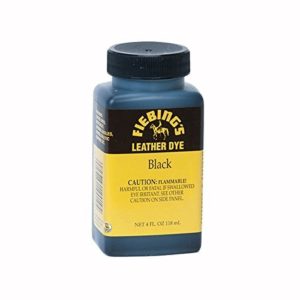
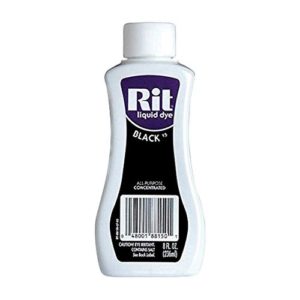
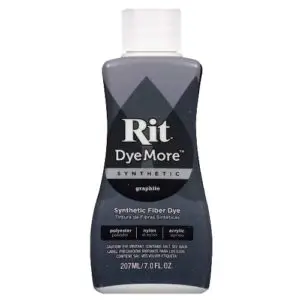
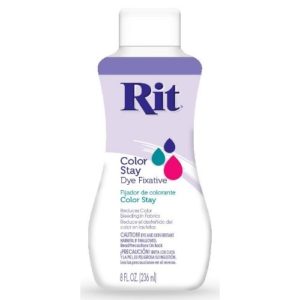
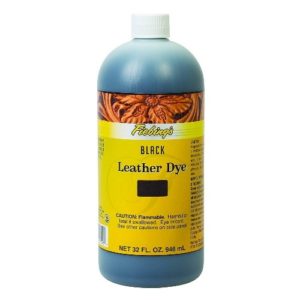
Are you looking for a high-quality leather dye? Dye enables you to customize or repair your leather products without covering the material’s natural grain and texture. With so many leather dyes on the market, it can be difficult to know which one is right for the project you have in mind.
To make things easier, we’ve reviewed our favorite leather dyes and brought you a comprehensive buying guide.
Fiebing’s Leather Dye – Editor’s Pick

 Fiebing’s Leather Dye is well-known remedy in the leather repair world. If you can get through the messy application process, you’re sure to be satisfied with the smooth, uniform finish provided by this retro-looking product. Feibing’s is alcohol-based, which means it won’t run or streak like water-based dyes.
Fiebing’s Leather Dye is well-known remedy in the leather repair world. If you can get through the messy application process, you’re sure to be satisfied with the smooth, uniform finish provided by this retro-looking product. Feibing’s is alcohol-based, which means it won’t run or streak like water-based dyes.
| Pros | Cons |
| Penetrating | Messy |
| Alcohol-based | – |
| Suitable for vegetable-tanned or unfinished leathers | – |
| Does not peel or crack | – |
| Flexible | – |
| Comes in black, dark brown, medium brown, maroon, light brown, and burgundy | – |
Rit Dye Liquid Fabric Dye – Best Budget Option
 If you’ve never tried Rit, you’d find it hard to believe how efficient this budget-rate dye can be. It’s suitable for use on a wide range of surfaces, including cotton, polyester, leather, and wood. What’s more, it comes in a never-ending rainbow of colors.
If you’ve never tried Rit, you’d find it hard to believe how efficient this budget-rate dye can be. It’s suitable for use on a wide range of surfaces, including cotton, polyester, leather, and wood. What’s more, it comes in a never-ending rainbow of colors.
If you’re a DIYer looking to add pizzazz to your next leather project, Rit’s reliable and robust palette is a good place to start. The 8-ounce bottles are extremely inexpensive. Not to mention, they provide full, streak-free coverage that’s guaranteed to last. These dyes are even certified non-toxic, meaning you don’t need to hide them from your children and pets. Of course, it’s important to keep in mind that they are highly concentrated and permanent.
| Pros | Cons |
| Suitable for fabric and leather | Need multiple bottles to each dark colors |
| Wide range of color options | – |
| 8-ounce plastic containers | – |
| All-purpose color formulas | – |
Rit DyeMore Advanced Liquid Dye
 Rit DyeMore is an advanced color formula that is engineered to adhere to synthetic fabrics, such as polyester, acrylic, acetate, and nylon. It is ideal for touching up vintage leather or vinyl pieces. What’s more, it can be used for unique, artistic projects. Despite its intensity, it is certified non-toxic.
Rit DyeMore is an advanced color formula that is engineered to adhere to synthetic fabrics, such as polyester, acrylic, acetate, and nylon. It is ideal for touching up vintage leather or vinyl pieces. What’s more, it can be used for unique, artistic projects. Despite its intensity, it is certified non-toxic.
You can even visit the manufacturer’s website to find hundreds of color recipes and dying techniques. There is also a wide assortment of premixed color formulas available. With that said, it is best to reserve this dye for fabrics that are at least 35% synthetic.
| Pros | Cons |
| Designed especially for fabrics consisting of 35% synthetic material | Must be used in a heated stainless steel pot |
| Comes in a rainbow of colors | – |
| Can be used to revitalize and repair | – |
| Over 250 recipes on the manufacturer’s website | – |
| Can be used for complex dying techniques | – |
Rit Dye Liquid Fabric Dye Fixative – Best Color Stay
 Sometimes, leather resists dyes. When this happens, a specially formulated color stay is a great solution. Rit’s fixative reduces color bleeding in most fabrics. However, it works best on cotton, linen, rayon, ramie. We love this project for dip-dye and tie-dye leather projects because it prevents the dye from bleeding.
Sometimes, leather resists dyes. When this happens, a specially formulated color stay is a great solution. Rit’s fixative reduces color bleeding in most fabrics. However, it works best on cotton, linen, rayon, ramie. We love this project for dip-dye and tie-dye leather projects because it prevents the dye from bleeding.
Keep in mind that it works best when used with Rit Dyes. It comes in 8-ounce bottles and is fairly inexpensive. Formula options include Basic and Limited Edition.
| Pros | Cons |
| Prevents dyes from bleeding | Must use boiling water to apply |
| Locks in and enhances colors | – |
| Works best with Rit Dyes | – |
| Lasts through multiple washings | – |
| Brings back faded color | – |
Feibling’s Black Leather Dye – Best Black Leather Dye
 When it comes to applying rich, dark finish to leather, you really cannot afford to mess around. Few products can master dark, robust blacks. However, Fiebling’s alcohol-based leather dye is known to penetrate deep below the surface to create a long-lasting jet black finish.
When it comes to applying rich, dark finish to leather, you really cannot afford to mess around. Few products can master dark, robust blacks. However, Fiebling’s alcohol-based leather dye is known to penetrate deep below the surface to create a long-lasting jet black finish.
It’s perfect for restoring vintage and well-worn pieces, including shoes, belts, wallets, and furniture. It’s also easy to daub on. The end result is a smooth, soft, crack-free surface that has the potential to last a lifetime.
| Pros | Cons |
| Alcohol-based | Messy |
| Does not peel or crack | – |
| Provides a rich, robust finish | – |
| Easy to use | – |
| Suitable for spot repairs | – |
Buyer’s Guide
How to Choose a Leather Dye
First off, it’s important to understand that leather dyes should be chosen with a specific project in mind. Consider the material you are working with as well as your desired results. Most leather and fabric dyes will only work on vegetable-tanned or untreated leathers. If you are unsure about the quality of your leather, you can perform tests to determine if it is vegetable-dyed.
Once you determine the type of leather you are working with, it’s time to choose a dye. Dyes may be oil-, water-, or alcohol-based. There’s no right or wrong type of leather dye base, but there are certainly advantages to each. For example, water-based dyes are easier to clean up. Moreover, alcohol-based dyes go on smoother and are less streaky.
It’s also important to consider the specific color formula you are looking. Some dye manufacturers offer a rainbow of colors. Meanwhile, others specialize in traditional leather shades. On top of that, many color formulas can be mixed together to create custom tones.
Video Guide: How to Dye Leather?
Benefits of Dying Leather
Leather is a naturally durable fabric that can last for hundreds of years. It even ages well, becoming a soft, flexible material with proper care. With that said, the dyes used to treat leather are likely to fade over time. As such, leather dye is a great way to rejuvenate your leather and breath new life into it. With the rise of DIY, leather dying has also become a popular technique. DIYers can use leather dye to create new or upcycled leather products.
With all that said, leather dyes often ram heads with leather paints. Both products are great but have varying capacities. Leather paint is perfect for creating intricate designs on leather. However, it often conceals the natural grain and texture of the material. On the other hand, dye is capable of penetrating leather. As such, you can alter the hue of the material without compromising its sought-after texture.
Precautions to Take When Dying Leather
Be Prepared for a Mess: Leather dye can be extremely messy! Wear work gloves and clothes when dying leather. What’s more, keep ample amounts of rags, paper towels, soap, and water on hand. Most leather dyes will stain your skin!
Prep the Leather: It’s imperative that you properly prep the leather before applying any dye. Use a scrub brush to remove any dirt or oils. Then, consider applying a bit of oil. This helps to lubricate the leather for better absorption. Regular household olive oil should do the trick!
Test Your Colors: If you have a bit of test leather to use, consider creating a palette of different dye blends and dilutions. This will help you to get a better understanding of what the dye looks like when it dries. You’ll be able to tweak it before applying it all over your project.
Leather Dyes FAQ
What can you use as leather dyes?
You may choose among commercial, natural and homemade leather dyes:
- Rust, mink oil, sunlight, brewed coffee, and vinegar as natural dyes for dark shades;
- Alcohol-based products for deep penetration;
- Water-based dyes are good for light tan coloring;
- Low VOC products (volatile organic compounds) for eco-friendly dyes;
- Pigments and paints;
- Antique colorants for delivering different vibrant colors;
- Shoe polish;
How can you dye your leather couch?
Begin by using acetone to disinfect a couch and then add a few coats of leather dye to the whole piece of furniture. Your sofa would look completely fresh within a couple of hours. White vinegar or alcohol rubbing can get rid of most stains.
The best leather dye can be found in certain art shops or online.
To make your sofa darker, you can quickly stain light leather, but it is more challenging to make a dark leather sofa look lighter. Do not apply the bright shades on a black or really dark sofa. You should add several coats of leather dye for medium-dark shades.
For 1 hour, let the first coat of dye dry and then apply 2-5 additional coats.
Wherever you buy leather dye, a leather finisher can be also a good investment. It may even be considered a top coat. For a more matte/satin finish, select a glossy finish product.
How to make a homemade leather dye?
Some industrial leather dyes produce poisonous pigments and should be treated with great care. Often, they may be costly. In many cases, you may make a DIY leather dye, allowing you greater control over the color and the safety of the natural or fake leather.
A few useful recipes of DIY leather dyes:
- Mix the regular rubbing alcohol and powdered mica pigment. The more pigments you add, the more intense color you get;
- Brew the vinegar with rusted steel wool. Just put the wool into a jar with boiling vinegar. Leave it for a few days. Mix it with any leather conditioner and apply to the leather surface;
- You may use red onions as a homemade leather dye. Boil them to get a certain shade of blue. To get a brownish dye, use fresh walnuts. But keep in mind that natural dyes give subtle colors;
Certain homemade leather dyes come with a strong odor. Let the applied leather pieces dry outdoors or in a well-ventilated place, away from your living room, before the odor fades.
And always wear gloves for protection.
Is it possible to dye leather with coffee?
Yes, you may use the brewed coffee to let leather a shade darker than it is. You can take cheap or expensive coffee beans to brew this dye. Here is what you should do:
- Get your coffee brewed. Make sure that it’s very strong;
- Set the gas stove to medium-high or set the coffee to a boiling point for around 2 minutes;
- Pull the pot from the stove and let it cool down for 5 to 10 minutes or so;
- You can now simply add coffee to the surface of the leather item, now that the coffee brew is ready;
- At one time, add a single layer and leave it dry. You should keep adding the coffee dye in layers until the perfect hue is received;
Allow the leather piece to sit in this homemade coffee dye for a few hours. After 1 hour, the surface will get a light walnut shade. After 4 hours, the leather piece will receive a deep walnut shade (it may be a bit uneven). After 8 hours, the treated piece will get a medium walnut shade.
Important notice: such a DIY coffee dye will only do for the natural veg tan leather colors. Also, after dyeing with coffee the leather item may become very dry. You need to use a leather conditioner.
How should you darken leather naturally?
To give your leather bags, shoes and accessories a fresh or nice vintage look, you may want to darken them with natural dyes instead of commercial products. Two traditional forms, without dyes, to darken leather naturally are:
1) With natural oils (mink oil, neatsfoot and coconut) – to make the leather piece a bit darker
- Pour a teaspoonful of the oil over a new, soft rag. That may be cotton, lint-free or microfiber cloth;
- Start rubbing the oil over the leather surface. At this stage, the aim is to add it to one uniform sheet. Often, in a back-and-forth motion, remember to rub only tiny parts before the whole leather surface is coated;
- After adding the first coat of oil, enable the leather to set and dry for approximately 10-12 hours or the whole night. Up to this point, the leather piece should become 2-3 shades darker than its original shade;
- You should apply as many coats of leather oil if you’re not pleased and would like the leather to look a bit darker;
2) With walnut hulls, you may add the natural rich brown shade
- Wear an apron and gloves to protect your hands from coloring;
- Add your walnut hulls into your container (about a half of it);
- Fill it with water;
- For around 1-2 weeks, leave the mixture to rest. The more it sits, the darker it will eventually be;
- Strain the walnut hulls juice from the bottle using an onion sack or a strainer;
- There are two ways in which the walnut hull solution may be used to darken the leather item. Through applying it over the leather surface, you may either soak the leather in the solvent or add it;
- You should rinse out the leather item (if you soaked it in the solution) after you’re done with the out. Otherwise, you can give the leather surface a simple wipe down using a damp cloth;
- Leave the leather piece to dry naturally;
- Apply a leather conditioner;
What is the most natural color of leather?
Russet, also known as Raw or Blond, is the most natural color of leather that comes out of the tannery before any dyes are added. Such leather is called vegetable tanned leather. A sort of medium tan color is the color of untreated natural leather.
Is it possible to dye leather with shoe polish?
For fading leather accessories and footwear, the use of shoe polish to dye leather is an especially good choice. It is possible to relate the color alteration and darkening that happens due to the wax components in a shoe polish. The waxes are absorbing, but an additional layer allows the leather piece to darken quickly.
Here is how you should apply a shoe polish to dye leather:
- Put a little polish product on the polishing rag;
- Start rubbing on the whole leather surface with the picked shoe polish;
- At this stage, the leather piece should start darkening. Continue to paint the leather until it has fully covered the whole surface;
- Buff the surface with the aid of your dry, comfortable rug;
- Let this leather piece dry overnight. You should add on another coat of polish if you like your piece of leather to look even darker;
Final Thoughts
We hope you enjoyed our leather dye buying guide. Leather is a durable, long-lasting material that should be treated with care. With the right products, you don’t need to worry about damaging your favorite shoes or armchair. Remember, leather dying is a fairly simple process that can be done without any experience. A single application can help a leather piece take on a new life.



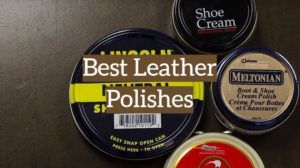





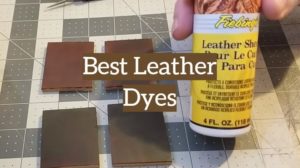
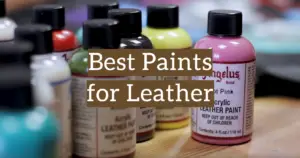

I use the Feibling’s Black Leather Dye on some products like 8 years ago and they are still very much alive and kicking. They don’t have any sign of peeling or cracking with the dye and look almost brand new. I’m going to put another coat on here soon to make them look good as new too.
The fact you have to heat up the Rit DyeMore Advanced Liquid Dye in a stainless steel pot kind of baffles me. Like why is that necessary?
Hello, Jill! It is necessary to use a pot because it is a hot water dye, and you have to heat water and mix it together.
My favorite is definitely the Fiebing’s Leather Dye. While it can be a bit messy, it does the job well and doesn’t take to much effort. Other than the cleanup.
Hello, Justin! Thanks for your comment.
Hi Steve
Im looking for a leather dye for shoes that does not dry with a high shine. Is there any product that you can recommend
Thanks
Jo 🙂
Hi, Jo! I would recommend to buy Fiebing’s Leather Dye. I often use it for my shoes.
I am looking for an off-white leather dye to repair scratches on my leather sofa. I am having trouble finding white or off-white, cream-colored furniture dye. Can you recommend any?
Hello! I would recommend to try this Fiebings Acrylic Dye. I think this will do.
Hi thanks, your review so useful. But may I ask something. I tried to deep dye with black color like you did and then made leather dry almost 12 hours before I made wallet from it. And the result is very good. But after putting my wallet on top of another wallet that is natural vegtan, the black color of the color wallet moves/clings to the natural vegtan color. Any treatment to leather after deep dye?
Hello, Rob! Once the black dye has dried I recommend taking a cloth and buffing away any dye residue and then applying a top coat. This will seal in the dye and should keep it from rubbing off. I also recommend using Fiebing’s Leather Dye.
Hello I’m wanting to dye my light brown leather couch to a wine color will the Rit dye work for this?
Hello, Belinda! Yes, this will do.
I want to dye a pair of beige walking shoes that are new. The top is leather but the sole is a polymer rubber blend. Will Fiebling’s alcohol leather dye also dye the synthetic material?
Hello, Lilly! It’s also good for polymer rubber blend.
Hi! I wonder can you advise me; I have a vintage convertible silver car with a blue canvas roof that gets covered with a blue leather hood when the roof comes down. The blue leather is ruststained and I am considering dying it. Is this a good option and if so, could you recommend a dye? (Living in the West of Ireland, if this matters).
Any suggestions gratefully accepted.
Eoghan
Hi, Eoghan! I would recommend buying Fiebings Leather Dye or Rit DyeMore. It’s my go-to dyes.
HI Steve
certain parts of my leather couch has faded due to light.
can I mix the leather dye with a leather cream and apply a brown” cream to darken the light areas?
your recommendation will be appreciated
Hello, yes you can. This works especially well with all of the brown tones and the primary colors like green and blue.
Hi, our two cream leather sofas in our Cyprus apartment have developed yellowing areas that seem to be where hot sweaty bodies sit and rest arms on. Has taken the colour out of the leather. What product can I use to restore the original cream?
Hello, Jill! I would recommend to use Fiebing’s or Rit Leather Dye.
Hi, Steve, my brown settees have patches where they have faded patches from continuous use head rest ect, what is the best permanent dye for these please?? Thank you
Hello, Kathy! I would recommend to try Fiebing’s Leather Dye. It’s really good.